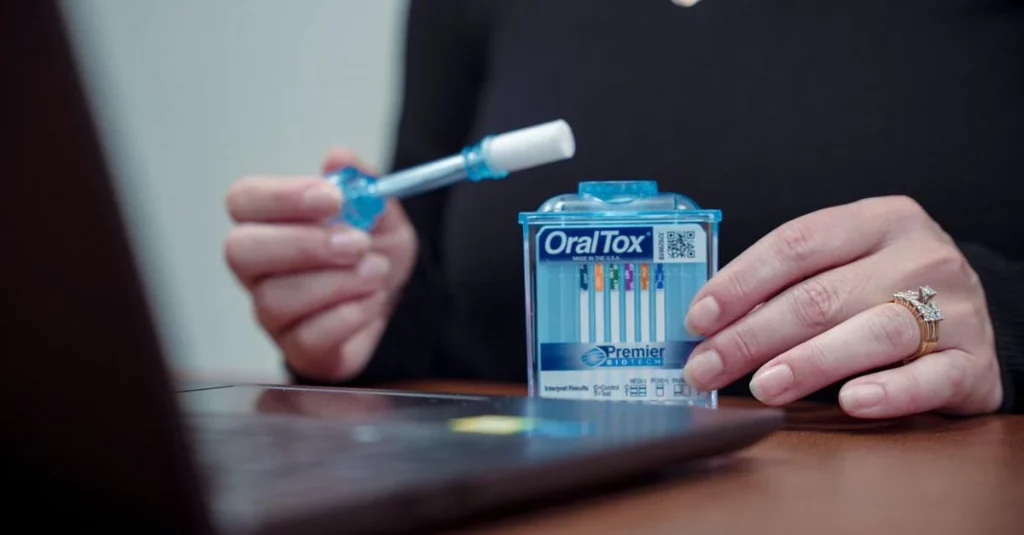Non-invasive drug detection innovation screening techniques offer a discreet and less stigmatizing approach to testing, raising important ethical considerations. This article examines the benefits and potential drawbacks of these techniques, with a focus on privacy and dignity.
However, accuracy and potential bias concerns need to be addressed. By critically exploring the ethical implications of drug detection innovation, this article aims to inform and engage readers on the challenges and opportunities of implementing non-invasive drug screening techniques.
Key Takeaways
- Non-invasive drug screening techniques are in high demand due to their convenience, reduced discomfort, and immediate results.
- Ethical concerns surrounding invasive drug testing methods include violation of privacy, stigmatization, and balancing public safety with individual rights.
- Non-invasive techniques, such as saliva and urine tests, offer advantages such as no needles or invasive procedures, shorter detection windows, and cost-effectiveness.
- Challenges in implementing non-invasive drug screening techniques include technology limitations, cost considerations, ethical concerns, legal compliance, and resistance to change.
The Need for Non-Invasive Drug Screening Techniques
The demand for non-invasive drug screening techniques has significantly increased in recent years. This rise can be attributed to several factors.
Firstly, the invasive nature of traditional drug screening methods, such as urine or blood tests, can be uncomfortable and invasive for individuals. Non-invasive techniques, on the other hand, offer a more comfortable and convenient alternative.
Additionally, non-invasive drug screening techniques have the potential to reduce the stigma associated with drug testing, as they can be performed discreetly and without drawing attention.
Furthermore, non-invasive methods can provide real-time results, allowing for immediate detection of drug use. This can be particularly beneficial in situations where quick and accurate results are necessary, such as in workplace testing or law enforcement settings.

Ethical Concerns Surrounding Invasive Drug Testing Methods
Ethical concerns arise with the use of invasive drug testing methods due to their potential for discomfort and violation of individuals’ privacy.
Invasive drug testing methods often involve procedures such as blood tests or urine samples, which can be physically uncomfortable and invasive. These methods may require individuals to provide personal information or bodily fluids, which can be seen as a violation of privacy.
Moreover, invasive drug testing can also lead to stigmatization and discrimination, as individuals may be judged based on the results of these tests.
The use of invasive drug testing methods raises questions about the balance between public safety and individual rights. While it is important to ensure a safe and drug-free environment, it is equally important to respect individuals’ autonomy and privacy.
Advantages of Non-Invasive Drug Screening Techniques
Non-invasive drug screening techniques offer several advantages over invasive methods, making them a preferred choice for drug testing.
One of the key advantages is that non-invasive techniques do not require the use of needles or other invasive procedures, reducing the discomfort and potential health risks for individuals being tested. This is particularly beneficial for children, the elderly, and those with needle phobia or medical conditions that make invasive procedures difficult.
Additionally, non-invasive techniques such as saliva or urine tests are less invasive and more convenient, allowing for easy sample collection and transportation. They also have a shorter detection window, providing more accurate and recent information about drug use.
Furthermore, non-invasive methods are less expensive and time-consuming compared to invasive techniques, making them more cost-effective for organizations conducting drug screening.
Challenges in Implementing Non-Invasive Drug Screening Techniques
Implementing non-invasive drug screening techniques presents several challenges that need to be addressed. These challenges include:
- Technology limitations: Non-invasive drug screening techniques are still in the early stages of development, and there are limitations in terms of accuracy and reliability. Further research and development are needed to improve the effectiveness of these techniques.
- Cost considerations: Implementing non-invasive drug screening techniques can be expensive, requiring specialized equipment and trained personnel. This can pose financial challenges for organizations, especially smaller ones with limited resources.
- Ethical concerns: Non-invasive drug screening techniques raise ethical questions regarding privacy and consent. Employees may feel that their rights are being violated, leading to potential legal and ethical issues for employers.
- Legal considerations: The use of non-invasive drug screening techniques may be subject to legal regulations and requirements. Organizations need to ensure compliance with applicable laws to avoid legal consequences.
- Resistance to change: Introducing new screening techniques can be met with resistance from employees and stakeholders who may be skeptical or resistant to change. Overcoming this resistance requires effective communication and education about the benefits and limitations of non-invasive drug screening techniques.
Promising Future Developments in Non-Invasive Drug Screening Methods
What advancements can we expect in the field of non-invasive drug screening methods in the near future?
As technology continues to evolve, there are several promising developments on the horizon.
One area of focus is the improvement of existing non-invasive techniques, such as saliva and sweat testing. Researchers are working on enhancing the sensitivity and accuracy of these methods, making them more reliable for drug screening purposes.
Additionally, advancements in imaging technology, such as functional magnetic resonance imaging (fMRI), may provide a non-invasive way to detect drug use by analyzing brain activity patterns.
Another area of potential progress is the development of wearable devices that can continuously monitor drug levels in the body. These devices could provide real-time data and alert individuals or healthcare professionals if drug use is detected.
Frequently Asked Questions
What Are Some Examples of Invasive Drug Testing Methods?
Some examples of invasive drug testing methods include urine drug tests, blood tests, and hair follicle tests.
Urine drug tests involve collecting a urine sample from the individual and analyzing it for the presence of drugs or their metabolites.
Blood tests require drawing blood from the individual and testing it for drug substances.
Hair follicle tests involve taking a hair sample and testing it for drug use history.
These invasive methods may raise ethical concerns due to their invasive nature and potential privacy violations.
How Do Non-Invasive Drug Screening Techniques Work?
Non-invasive drug screening techniques work by analyzing biological samples such as urine, saliva, hair, or sweat to detect the presence of drugs in a person’s system. These techniques are designed to be less invasive than traditional methods such as blood or urine tests, making them more comfortable and convenient for individuals undergoing drug screening.
Are Non-Invasive Drug Screening Techniques Accurate and Reliable?
Non-invasive drug screening techniques have emerged as a promising alternative to traditional methods. However, the question of their accuracy and reliability remains.
Studies have shown that these techniques can provide accurate results for certain drugs, such as marijuana and cocaine. However, there are limitations in detecting some substances, including prescription drugs and synthetic opioids.
It is crucial to consider the specificity and sensitivity of these techniques before implementing them on a large scale. Additionally, ethical considerations, such as privacy and consent, must be carefully addressed to ensure the responsible use of non-invasive drug screening techniques.
What Are the Potential Benefits of Using Non-Invasive Drug Screening Techniques?
Non-invasive drug screening techniques offer several potential benefits in the field of drug testing. These techniques eliminate the need for invasive procedures such as blood tests or urine samples, making the process more comfortable and less invasive for individuals.
Additionally, non-invasive techniques can be performed quickly and easily, allowing for efficient screening in various settings such as workplaces or schools.
Furthermore, these techniques may also provide a more cost-effective option compared to traditional drug screening methods.
Are There Any Limitations or Drawbacks to Non-Invasive Drug Screening Techniques?
There are limitations and drawbacks to non-invasive drug screening techniques.
One of the main limitations is the potential for false positive or false negative results.
Non-invasive methods rely on detecting drug metabolites in bodily fluids or samples, which may not always accurately reflect recent drug use.
Additionally, non-invasive techniques may not be as sensitive or specific as invasive methods, leading to less reliable results.
Ethical considerations also arise in terms of privacy and consent when implementing non-invasive drug screening techniques.
Conclusion
In conclusion, non-invasive drug screening techniques offer a promising alternative to invasive methods, addressing ethical concerns while maintaining privacy and dignity for individuals.
However, the accuracy and reliability of these techniques must be carefully evaluated to ensure consistent and dependable results.
Additionally, potential biases and discrimination should be addressed to prevent any negative consequences.
Further research and development in non-invasive drug screening methods are necessary to overcome the challenges and maximize the benefits of these techniques.
You may also like to read:
The Mobile Revolution: Unraveling the Tapestry of Technological Marvels
